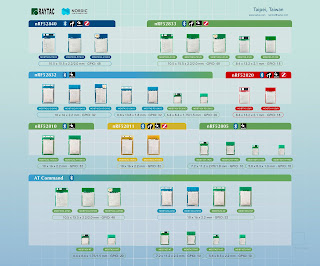Raytac's pre-certified module for your convenience - but how?
So, in this post, we would like to take you on a little journey through most of the important certifications that Raytac has pre-certified their modules with.
The exact topic is actually what you need to know and what that means to you as a Raytac customer.
Obviously, each and every certification has their own rules, so that's how we're going to do this - one by one.
So for the FCC certification, you can as a Raytac customer:
What you will need to do is:
Firstly, for the wireless test, you can refer to Raytac's own certification report so that the lab knows the module itself has passed although it still needs to be tested.
Secondly, the for wire (IO port) test, you will have to do from scratch essentially.
Thus, even though we have applied for KC for our modules, you will still have to test them locally.
Thus, the procedure becomes:
When applying to this certification, you will be in either of these two circumstances:
As always - Happy tinkering everybody :)
So, in this post, we would like to take you on a little journey through most of the important certifications that Raytac has pre-certified their modules with.
The exact topic is actually what you need to know and what that means to you as a Raytac customer.
Obviously, each and every certification has their own rules, so that's how we're going to do this - one by one.
- FCC - (U.S.A.)
So for the FCC certification, you can as a Raytac customer:
- Use Raytac's certification ID directly on your finished product's label But you need to:
- Test FCC Part 15B EMC for your finished products
- IC - (Canada)
- Use Raytac's certification ID on your finished product's label (same as FCC) But, just like FCC, you need to:
- Test IC ES003 (EMC)
- This can be combined together with the FCC Part 15B test
- TELEC - (Japan)
What you will need to do is:
- Use Raytac's certification ID on your finished product's label
- KC - (South Korea)
- Test EMC for wireless (KN301489 - same as CE's EN301489)
- Test EMC for wire (IO port) (KN3235)
- If, and only if, your final product is equipped with IO ports, that is.
Firstly, for the wireless test, you can refer to Raytac's own certification report so that the lab knows the module itself has passed although it still needs to be tested.
Secondly, the for wire (IO port) test, you will have to do from scratch essentially.
Thus, even though we have applied for KC for our modules, you will still have to test them locally.
- CE (Radio Equipment Directive 2014/53/EU (RED)) - (EEA, Europe)
- Test on Conducted engineering sample (EN300328)
- You can refer to Raytac's test report, if the test lab accepts it, that is.
To ensure that they do, you can choose to conduct your tests at the same lab as Raytac - SGS.
- You can refer to Raytac's test report, if the test lab accepts it, that is.
- Test on Radiated engineering sample (EN300328)
- Test EMC (EN301489)
- Test Safety (EN60950)
- Subject to change to EN62368 in 2021
- SRRC
- Your end product can either be defined as a "Home Appliances" or an "Office Utilities" product
- Then you can simply refer Raytac's SRRC ID (module policy just like FCC/IC/TELEC)
- Your end product is neither of the above
- You have to apply for your own SRRC ID by testing everything required by the regulation
- NCC
Thus, the procedure becomes:
- Adding functionality of an already existing feature (a.k.a. platform)?
- Then you can simply refer Raytac's NCC ID on your product (module policy just like FCC/IC/TELEC/SRRC)
- New ideas/features?
- Sorry, you have to apply for your own NCC ID by conducting all tests necessary
- RCM
When applying to this certification, you will be in either of these two circumstances:
- CE already done.
- You can refer to your own CE certification and ask your test lab to copy the report to your RCM application.
- CE NOT done.
- You must conduct the test from scratch. But it is a whole lot like CE, meaning:
- Test on Conducted engineering sample
- Test on Radiated engineering sample
- Test EMC
- Test Safety
- Bluetooth Certification
- Apply for Bluetooth SIG's "Adopter Membership" (free)
- You can apply for the membership here
- Purchase your DID
- You can do this directly at Bluetooth SIG's website
- Leverage Raytac's QDID
- To activate your newly purchased DID
- Hardware
- Unless you are still using Raytac's module
- Feature
- Unless you are still using Raytac's module
- Brand Name
- Brand name remains unchanged.
As always - Happy tinkering everybody :)
Raytac Corporation 勁達國際電子有限公司 A BT 5.1 & BT 5 & BT 4.2 module maker based on Nordic nRF51 & nRF52 solution (nRF52840 & nRF52832 & nRF52811 & nRF52810 & nRF51822)
| www.raytac.com | email: cs@raytac.com | Tel: +886.2.3234.0208 |





